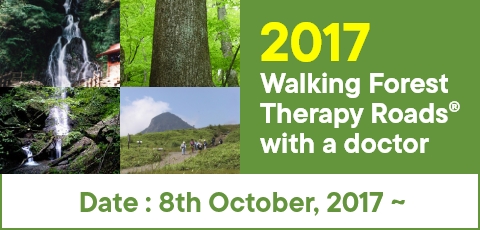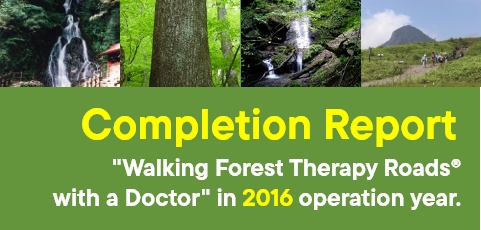NEWS&PRESS
Forest Policy and Forest Healing in the Republic of Korea
Last Updated:October 10, 2015
Dr. SHIN, Won Sop
Minister of Korea Forest Service
In recent years, lifestyles have drastically changed because of rapid urbanization and advances in technology. This has led to numerous lifestyle-related health problems in modern society. Despite advances in medical technology, the prevalence of chronic or untreatable diseases continues to increase. Further, the rising cost and side effects of medical treatments lead people to look for alternative ways to cope with their health problems.
The prevalence of chronic diseases, lifestyle-related diseases, environmental diseases, and so on is constantly increasing, as is that of psychological disorders such as stress, depression, and addiction.
Since ancient times, humans have evolved within nature. Modern health problems are believed to originate from their disconnect with nature. Forests are considered an effective healing method because of their relaxing environment, including beautiful scenery, phytoncides, and the relaxing sound of birds.
With increasing scientific evidence on the therapeutic effects of the forest environment, people’s interest in and demand for forest healing have been rapidly rising.
Korea’s forests account for about 2/3rd of the total land area. The Republic of Korea successfully transformed its denuded land into rich forests in less than half a century. There has been a continuous increase in the number of people visiting forests, and 81.3% of the Korean people visit forests more than once a year. According to a survey conducted in 2012, forest walking and hiking were ranked among Koreans’ most-preferred leisure activities, and the number of people enjoying these activities is increasing annually.
The Korea Forest Service (KFS) facilitated ‘Forest Healing’ to utilize forests for enhancing health and quality of life. The KFS has legalized the concept of forest healing and launched a forest healing instructor system to develop and manage forest healing programs.
To expand the scope of forest healing, the KFS plans to establish 34 national and public healing forests and 2 national forest healing centers by 2017. The KFS plans to train over 500 forest healing instructors to provide specialized healing services to the public. Along with these aims, the KFS continues to perform research on forest ㅡmedicine, such as comprehensive medical research on forest healing through interdisciplinary approaches.
Currently, a number of people visit healing forests each year with a high level of satisfaction: 790,000 people in 2013 and one million people in 2014. In a survey in 2013, 98.6% of the visitors responded that the forest healing program was satisfactory. With the increasing demand for forest healing, 24 additional healing forests are currently being established. The National Forest Healing Center is now under construction and anticipated to become the landmark of forest healing in Korea. This Center will play a key role in research, long-term stay, and education on forest healing. Research on the therapeutic effects of forest environment, development of healing programs, services, and forest education will be carried out in this center.
There has been growing interest in forest healing instructors; just 3 years after the introduction of the forest healing instructor system, a total of 165 instructors were trained at 9 institutions certified by the KFS.
There has been rigorous evidence showing the therapeutic effects of forests. First, the forest environment can boost the immune system by increasing the number of natural killer cells, which may facilitate recovery from cancer. Actually, the forest healing program was found to facilitate the recovery of breast cancer patients. Second, forests can relieve the symptoms of environmental diseases. Patients with pediatric asthma or atopic dermatitis obtained relief from their symptoms after undergoing a forest healing program. Third, forests can improve psychological stability in patients with depression and alcoholism. Scores on the Beck Depression Inventory decreased among patients with depression and scores on a self-esteem measure increased among individuals with alcohol use disorder, after participating in a forest healing program. Finally, forests offer many other benefits such as improving cognitive ability. A study showed that a 30-min forest trek decreased negative feelings such as stress, depression, anger, fatigue, anxiety, and confusion, and improved cognitive skills.
It is becoming increasing necessary to utilize forests to enhance public wellbeing. As the Republic of Korea has been rapidly aging and is anticipated to become one of the most aged countries by 2020, the government expects that medical expenses will increase continuously. Numerous studies show that forest healing can reduce stress, preventing it from developing into more severe illnesses. Widespread media coverage on the therapeutic function of forests has substantially increased public attention to forests. The private and public sectors both contribute to provide forest healing services to meet the rising public demand. Medical groups have started to use forest facilities in order to provide evidence of the therapeutic effect of forests. Additional studies are being conducted to develop scientific technology that can immediately contribute to improve people’s quality of life.
As public interest in wellbeing has been rising in recent years, the KFS has been promoting the policy of “From cradle to grave: Life with forests.” The Law on Forest Welfare Promotion was enacted in March 2015 by the National Assembly. It provides comprehensive forest welfare services customized by life stage from cradle to grave. This Act is thus a timely and appropriate move towards the establishment of an institutional base for promoting systematic forest welfare services. It is worth noting that the term “forest welfare” refers to socioeconomic and emotional support for public welfare promotion by offering cultural, recreational, educational, and therapeutic services through forest kindergartens, camping, healing forests, tree burial, and so on.
Nevertheless, many tasks are yet to be completed in the field of forest healing. Among these is the urgent need to develop and implement policies for diversifying and vitalizing private forest-related markets. It is also important to support private businesses and create jobs in relation to forest welfare. Furthermore, ministries or government departments that are concerned with public welfare, such as the Ministry of Health and Welfare, Ministry of Education, and the KFS, should collaborate closely.
As forest healing is gaining global interest, forest partner countries are actively exchanging relevant information. The International Symposium on Forest Healing took place on December 2014 in Seoul, where experts from Germany, Japan, Demark, and the Republic of Korea shared their insights on research trends and discussed future directions.
A High Level Dialogue in the field of forestry is convened on a regular basis between the Republic of Korea and Japan. During the 2nd Dialogue, in November last year, the Minister of the KFS, Dr. SHIN Won Sop, and the Director General of Forestry Agency of Japan, Mr. Satoshi Imai, met and agreed to carry out academic exchanges in forest healing. It is expected that the two countries will participate in active exchanges and closely collaborate with each other.
Globally, forest healing has attracted the attention of researchers in a wide range of fields, like forestry, psychology, health promotion, and medicine. Therefore, evidence of diversified forest healing and in-depth research are necessary to encourage the people to actually enjoy the benefits and experience the effectiveness of forest healing.



